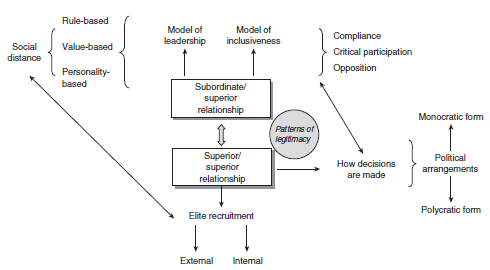The schema in Figure 11.1 summarizes the idea of political performance. As we proposed previously, the political performance of organizations lies primarily in the patterns of authority encompassed in the political relationship of subordina- tion and in the political relationship between rival leaders. To be brief, political performance is produced by the interactions between four characteristics of political systems. These comprise the model of leadership (the basis of the distance between the elite and the governed), the model of inclusiveness (the degree of required and tolerated participation), the decision-making model (from open dialog to monocratic forms of imposition), and the model of elite production (endogenously organized through career-functional types of backgrounds or exogenously generated through educational-familial-social kinds of backgrounds).

Figure 11.1 The production of political performance
The figure suggests the existence of diverse types of political performance. For instance, an organization producing its elite through internal mechanisms of career, making decisions through deliberative settings, privileging personality-based types of leadership and critical participation, would generate a specific type of political performance, a sort of intermingling between social resistance, avoidance, and the power of charisma. An organization recruiting its elites externally, making decisions from the center, valuing a leadership based on rules and a compliance-based model of inclusiveness, would resemble a bureaucratic type of political performance, i.e. a mix of structural and procedural stability and of externally generated forms of values and authenticity. 5
Usually, two categories of assumption help define the agenda when studying political performance. The first assumption is that the stability of governments is related to the way organizational forms are constructed (e.g. participative forms, decision-making processes and procedures, pathways to the top of an organiza- tion). Implicitly, this means that forms of governmentality are a mechanism ‘that work[s] efficiently in any setting if properly engineered in accordance with rules distinctive to themselves’ (Eckstein 1969: 275). A second assumption is that politi- cal performance depends primarily not on the internal structures of powers, but on external ingredients, such as geography, education, social stratification, and so on. Both approaches have been largely recognized as insufficient in the attempt to elab- orate a model for understanding the stability of organizational/political regimes (Eckstein 1969; Linz 1978). It is in the patterns of internal structures and relations of power that the stability and dynamics of (democratic and oligarchic) forms of organization can be better grasped. Political performance is analyzed in Eckstein’s (1969: 287) model according to the following items:6
- durability, i.e. the persistence of a certain government without major change over time
- legitimacy, e. the ability of a certain government ‘to command positive com-mitments in a society’
- strife avoidance, i.e. the ability of a certain government to avoid or minimize social violence directed at the structure of rule
- output efficiency, i.e. the ability of a certain government ‘to arrive at directives pertinent to demands in a polity, especially intense and widespread ones’
- permeation, i.e. the ability of the power holders to distribute resources and carry out reforms pertinent for the various segments of the social body
- authenticity, which means that all these aspects should be accomplished with- out deviating from some sorts of implicit meanings (what it means to be a democratic leader, for instance), the political formulas, to follow (Mosca 1939).
Accordingly, all these dimensions relate to three political characteristics of orga- nizational forms. Organizational forms are designed to generate certain kinds of rules, of subordinate–superior relationships, and certain patterns of elite pro- duction. In other words, organizational forms might be the major ingredient of a system of governance. From the perspective of the power holders, the political pur- pose of any government is to perpetuate itself. It does not do so when a dominant leader is ousted for whatever reason and organizational lives are affected, when the organization necessarily lives a drama symbolized by the transfer of power, such as in the context of changes in political regimes at the level of nations or a change of top management team or CEO (Linz 1978: 3).
Where the very essence of the legitimacy of leaders is contested and, as is often the case, ends up in the unveiling of scandals or actual proof of incompetence, the lack of political performance is interpreted as a pivotal event and shatters the entire organizational edifice. In the upshot, it is the corporate elite as a ‘ruling class’ which is affected, and which, therefore, strives to recover both the trust of destabilized subordinates, and the dignity of an aristocracy. Unobtrusively, corporate elites use the power of their inter-organizational networks (Davis et al. 2003) and slightly reorient the rules of their most powerful resource, the system of elite recruitment (Putnam 1976).7
We turn now to the analysis of the dynamics of contemporary political struc-tures of organizations. We remind the reader that the purpose of the dynamic we are going to emphasize, namely the polyarchic dynamic, is to stabilize, if not increase, the political performance of organizations as defined above.
Source: Clegg Stewart, Courpasson David, Phillips Nelson X. (2006), Power and Organizations, SAGE Publications Ltd; 1st edition.
